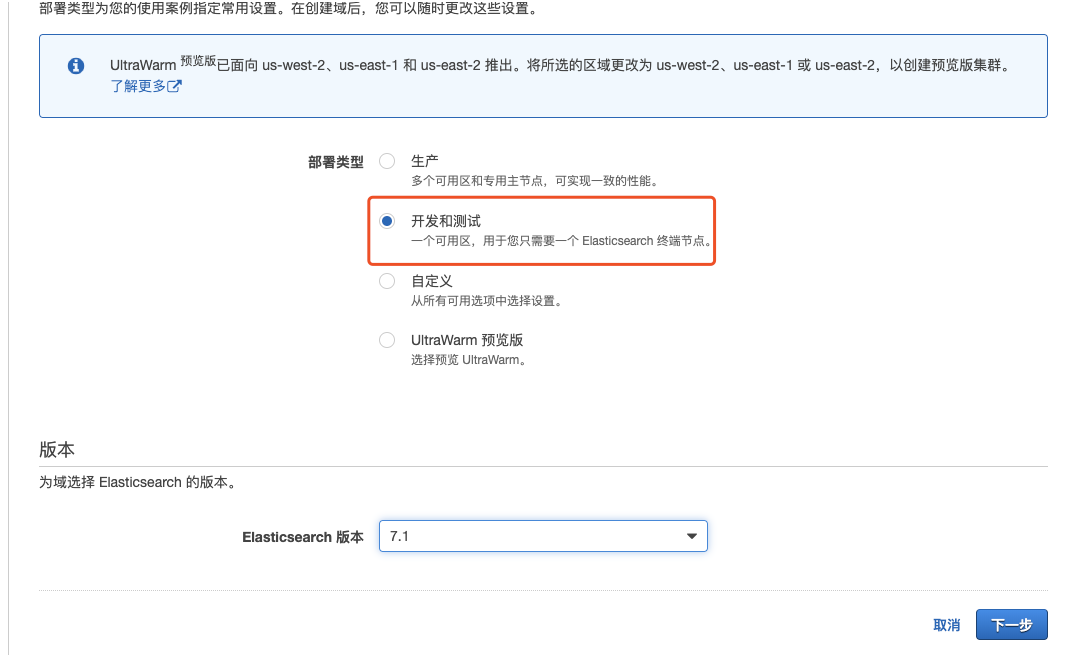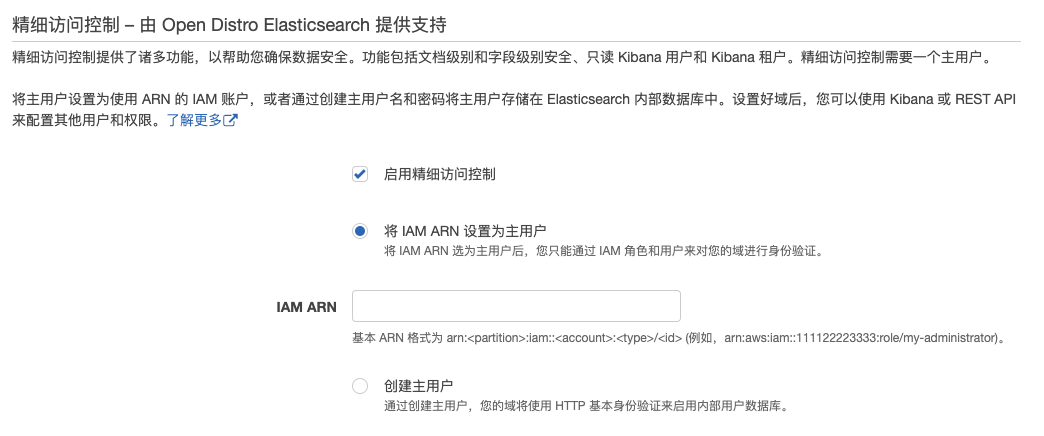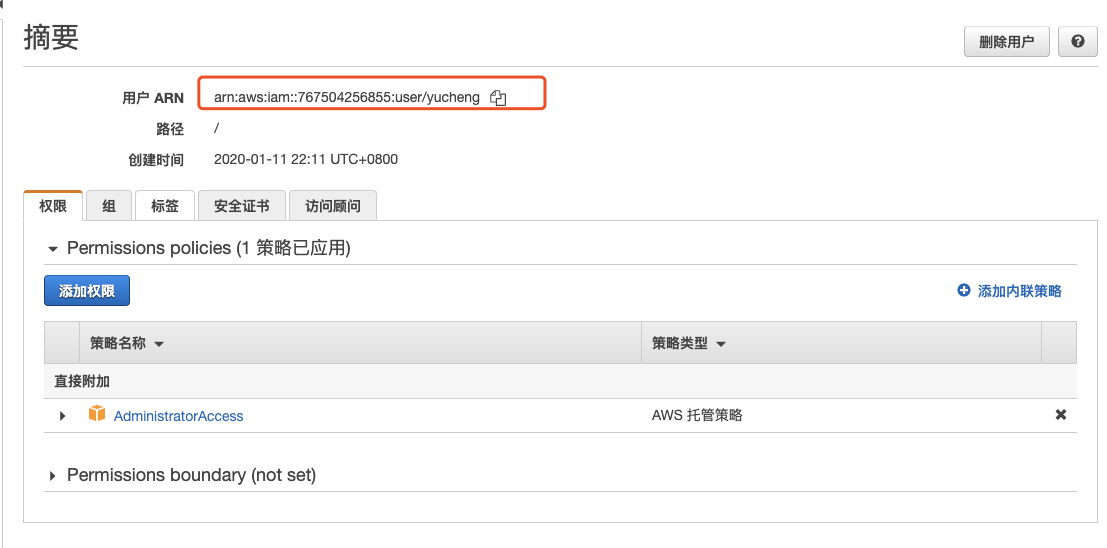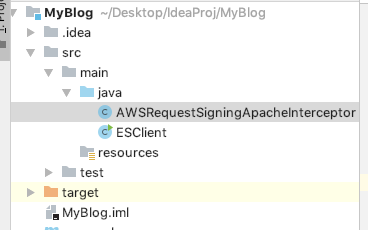Amazon Elasticsearch Service 使用户能够在云中轻松地设置、操作和扩展 Elasticsearch 集群。
第一步:创建




这里面有一个IAM ARN,需要去IAM服务中寻找,如下图所示。

访问策略如下:
{
"Version": "2012-10-17",
"Statement": [
{
"Effect": "Allow",
"Principal": {
"AWS": "arn:aws:iam::767504256855:user/yucheng"
},
"Action": "es:*",
"Resource": "arn:aws:es:us-east-1:767504256855:domain/yucheng/*"
}
]
}第二步:保存终端节点和密钥
创建成功之后有一个终端节点的链接,需要保存下来。

除了这个终端节点,还有一个区域也需要记录。

在IAM服务中下载密钥。
第三步 创建JAVA的maven工程与编码
maven配置
<build>
<plugins>
<plugin>
<groupId>org.apache.maven.plugins</groupId>
<artifactId>maven-compiler-plugin</artifactId>
<configuration>
<source>1.8</source>
<target>1.8</target>
</configuration>
</plugin>
</plugins>
</build>
<dependencies>
<dependency>
<groupId>com.amazonaws</groupId>
<artifactId>aws-java-sdk-core</artifactId>
<version>1.11.327</version>
</dependency>
<dependency>
<groupId>org.elasticsearch</groupId>
<artifactId>elasticsearch</artifactId>
<version>7.1.1</version>
</dependency>
<dependency>
<groupId>org.elasticsearch.client</groupId>
<artifactId>elasticsearch-rest-client</artifactId>
<version>7.1.1</version>
</dependency>
<dependency>
<groupId>org.elasticsearch.client</groupId>
<artifactId>elasticsearch-rest-high-level-client</artifactId>
<version>7.1.1</version>
</dependency>
</dependencies>
编码测试。

AWSRequestSigningApacheInterceptor
这个类是官方提供的,需直接拷贝。
/*
* Copyright 2012-2017 Amazon.com, Inc. or its affiliates. All Rights Reserved.
*
* Licensed under the Apache License, Version 2.0 (the "License"). You may not use this file except in compliance with
* the License. A copy of the License is located at
*
* http://aws.amazon.com/apache2.0
*
* or in the "license" file accompanying this file. This file is distributed on an "AS IS" BASIS, WITHOUT WARRANTIES OR
* CONDITIONS OF ANY KIND, either express or implied. See the License for the specific language governing permissions
* and limitations under the License.
*/
import com.amazonaws.DefaultRequest;
import com.amazonaws.auth.AWSCredentialsProvider;
import com.amazonaws.auth.Signer;
import com.amazonaws.http.HttpMethodName;
import org.apache.http.Header;
import org.apache.http.HttpEntityEnclosingRequest;
import org.apache.http.HttpException;
import org.apache.http.HttpHost;
import org.apache.http.HttpRequest;
import org.apache.http.HttpRequestInterceptor;
import org.apache.http.NameValuePair;
import org.apache.http.client.utils.URIBuilder;
import org.apache.http.entity.BasicHttpEntity;
import org.apache.http.message.BasicHeader;
import org.apache.http.protocol.HttpContext;
import java.io.IOException;
import java.net.URI;
import java.net.URISyntaxException;
import java.util.ArrayList;
import java.util.List;
import java.util.Map;
import java.util.TreeMap;
import static org.apache.http.protocol.HttpCoreContext.HTTP_TARGET_HOST;
/**
* An {@link HttpRequestInterceptor} that signs requests using any AWS {@link Signer}
* and {@link AWSCredentialsProvider}.
*/
public class AWSRequestSigningApacheInterceptor implements HttpRequestInterceptor {
/**
* The service that we're connecting to. Technically not necessary.
* Could be used by a future Signer, though.
*/
private final String service;
/**
* The particular signer implementation.
*/
private final Signer signer;
/**
* The source of AWS credentials for signing.
*/
private final AWSCredentialsProvider awsCredentialsProvider;
/**
*
* @param service service that we're connecting to
* @param signer particular signer implementation
* @param awsCredentialsProvider source of AWS credentials for signing
*/
public AWSRequestSigningApacheInterceptor(final String service,
final Signer signer,
final AWSCredentialsProvider awsCredentialsProvider) {
this.service = service;
this.signer = signer;
this.awsCredentialsProvider = awsCredentialsProvider;
}
/**
* {@inheritDoc}
*/
@Override
public void process(final HttpRequest request, final HttpContext context)
throws HttpException, IOException {
URIBuilder uriBuilder;
try {
uriBuilder = new URIBuilder(request.getRequestLine().getUri());
} catch (URISyntaxException e) {
throw new IOException("Invalid URI" , e);
}
// Copy Apache HttpRequest to AWS DefaultRequest
DefaultRequest<?> signableRequest = new DefaultRequest<>(service);
HttpHost host = (HttpHost) context.getAttribute(HTTP_TARGET_HOST);
if (host != null) {
signableRequest.setEndpoint(URI.create(host.toURI()));
}
final HttpMethodName httpMethod =
HttpMethodName.fromValue(request.getRequestLine().getMethod());
signableRequest.setHttpMethod(httpMethod);
try {
signableRequest.setResourcePath(uriBuilder.build().getRawPath());
} catch (URISyntaxException e) {
throw new IOException("Invalid URI" , e);
}
if (request instanceof HttpEntityEnclosingRequest) {
HttpEntityEnclosingRequest httpEntityEnclosingRequest =
(HttpEntityEnclosingRequest) request;
if (httpEntityEnclosingRequest.getEntity() != null) {
signableRequest.setContent(httpEntityEnclosingRequest.getEntity().getContent());
}
}
signableRequest.setParameters(nvpToMapParams(uriBuilder.getQueryParams()));
signableRequest.setHeaders(headerArrayToMap(request.getAllHeaders()));
// Sign it
signer.sign(signableRequest, awsCredentialsProvider.getCredentials());
// Now copy everything back
request.setHeaders(mapToHeaderArray(signableRequest.getHeaders()));
if (request instanceof HttpEntityEnclosingRequest) {
HttpEntityEnclosingRequest httpEntityEnclosingRequest =
(HttpEntityEnclosingRequest) request;
if (httpEntityEnclosingRequest.getEntity() != null) {
BasicHttpEntity basicHttpEntity = new BasicHttpEntity();
basicHttpEntity.setContent(signableRequest.getContent());
httpEntityEnclosingRequest.setEntity(basicHttpEntity);
}
}
}
/**
*
* @param params list of HTTP query params as NameValuePairs
* @return a multimap of HTTP query params
*/
private static Map<String, List<String>> nvpToMapParams(final List<NameValuePair> params) {
Map<String, List<String>> parameterMap = new TreeMap<>(String.CASE_INSENSITIVE_ORDER);
for (NameValuePair nvp : params) {
List<String> argsList =
parameterMap.computeIfAbsent(nvp.getName(), k -> new ArrayList<>());
argsList.add(nvp.getValue());
}
return parameterMap;
}
/**
* @param headers modeled Header objects
* @return a Map of header entries
*/
private static Map<String, String> headerArrayToMap(final Header[] headers) {
Map<String, String> headersMap = new TreeMap<>(String.CASE_INSENSITIVE_ORDER);
for (Header header : headers) {
if (!skipHeader(header)) {
headersMap.put(header.getName(), header.getValue());
}
}
return headersMap;
}
/**
* @param header header line to check
* @return true if the given header should be excluded when signing
*/
private static boolean skipHeader(final Header header) {
return ("content-length".equalsIgnoreCase(header.getName())
&& "0".equals(header.getValue())) // Strip Content-Length: 0
|| "host".equalsIgnoreCase(header.getName()); // Host comes from endpoint
}
/**
* @param mapHeaders Map of header entries
* @return modeled Header objects
*/
private static Header[] mapToHeaderArray(final Map<String, String> mapHeaders) {
Header[] headers = new Header[mapHeaders.size()];
int i = 0;
for (Map.Entry<String, String> headerEntry : mapHeaders.entrySet()) {
headers[i++] = new BasicHeader(headerEntry.getKey(), headerEntry.getValue());
}
return headers;
}
}
ESClient
这个类是自己实现的,在构造RestHighLevelClient之时,与普通Elasticsearch不同的是需要添加一些认证的操作。
import com.amazonaws.auth.AWS4Signer;
import com.amazonaws.auth.AWSCredentials;
import com.amazonaws.auth.AWSCredentialsProvider;
import com.amazonaws.auth.AWSStaticCredentialsProvider;
import com.amazonaws.auth.BasicAWSCredentials;
import org.apache.http.HttpHost;
import org.apache.http.HttpRequestInterceptor;
import org.elasticsearch.action.index.IndexRequest;
import org.elasticsearch.action.index.IndexResponse;
import org.elasticsearch.client.RequestOptions;
import org.elasticsearch.client.RestClient;
import org.elasticsearch.client.RestHighLevelClient;
import java.io.IOException;
import java.util.HashMap;
import java.util.Map;
public class ESClient {
private static String AWS_ACCESS_KEY_ID = "XXX";//替换成自己的
private static String AWS_SECRET_ACCESS_KEY = "XXXXX";//替换成自己的
public static RestHighLevelClient getClient() {
AWSCredentials credentials = new BasicAWSCredentials(AWS_ACCESS_KEY_ID, AWS_SECRET_ACCESS_KEY);
AWS4Signer signer = new AWS4Signer();
AWSCredentialsProvider credentialsProvider = new AWSStaticCredentialsProvider(credentials);
signer.setServiceName("es");
signer.setRegionName("us-east-1");
HttpRequestInterceptor interceptor = new AWSRequestSigningApacheInterceptor(
"es", signer, credentialsProvider);
return new RestHighLevelClient(RestClient.builder(
HttpHost.create("https://search-yucheng-wnevxf2cs6ijij6lloqgbf537u.us-east-1.es.amazonaws.com")).
setHttpClientConfigCallback(hacb -> hacb.addInterceptorLast(interceptor)));
}
public static void main(String[] args) {
RestHighLevelClient client = ESClient.getClient();
Map<String, Object> map = new HashMap<>();
map.put("name", "yucheng");
IndexRequest indexRequest = new IndexRequest("yucheng").source(map);
try {
IndexResponse indexResponse = client.index(indexRequest, RequestOptions.DEFAULT);
System.out.println(indexResponse);
} catch (IOException e) {
e.printStackTrace();
}
}
}
结果

最后
以上就是怕孤单八宝粥最近收集整理的关于Amazon Elasticsearch Service 入门实践的全部内容,更多相关Amazon内容请搜索靠谱客的其他文章。
本图文内容来源于网友提供,作为学习参考使用,或来自网络收集整理,版权属于原作者所有。








发表评论 取消回复